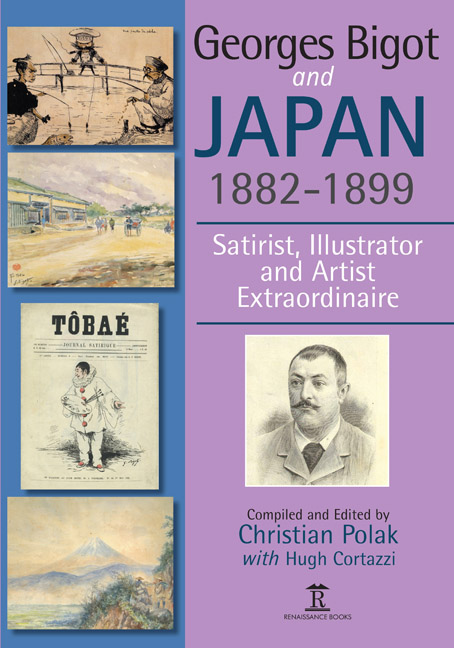Charles Wirgman (1835–1891): Artist, Journalist and Caricaturist – Forerunner to Georges Bigot in Japan
Published online by Cambridge University Press: 30 April 2022
Summary
Charles Wirgman was a British artist who arrived in Japan in 1861 soon after the opening of the Treaty Ports in 1859. He settled in Yokohama where he died in 1891.
Wirgman was the son of a silversmith in London of Swedish extraction. He was probably born there but spent much of his youth in France and Germany. He does not seem to have had much in the way of formal education, although it has been suggested that he may have attended a military school for a time. Between 1852 and 1855 he joined an artist's studio in Paris and learnt to draw, although he seems otherwise to have lacked professional art training. He has been criticized for the amateurism of some of his early work but his skills improved with experience. He must have had an eagle eye and a talent for drawing enabling him to capture in a quick sketch the actions that he observed.
He spoke fluent French and German and happily quoted phrases in other European languages as well as Latin. He quickly learnt to speak Japanese with fluency. He acted occasionally as an interpreter and achieved some competence in the written language.
He was described when in his mid-twentie as being ‘a well-built man of average height with thick brown hair, open forehead, clever, bright eyes, laughing mouth and large nose’.
He was gregarious and determined to enjoy life to the full, patronizing places of amusement including the brothels of Yokohama and Edo in the company of his English friends. He developed genuine affection for Japanese people, ‘marrying’ a Japanese girl (Ozawa Kane) and fathering a son named Ichiro in 1864. He chose to set up house in Yokohama and saw himself as a Yokohama- jin [man].
He retained till late in life the exuberance of a schoolboy, having a penchant for deadpan humour. He loved puns and aphorisms. He liked to appear as an English eccentric trying to shock the staid members of both the foreign and Japanese communities. He often wandered around in Japanese dress or would appear in informal garb without a tie.
He first came to Japan as correspondent and draughtsman for the Illustrated London News (ILN) in April 1861.
- Type
- Chapter
- Information
- Georges Bigot and Japan 1882-1889Satirist, Illustrator and Artist Extraordinaire, pp. 34 - 40Publisher: Amsterdam University PressPrint publication year: 2018

